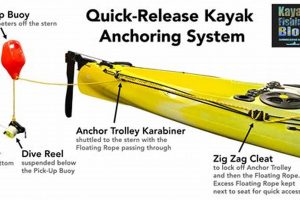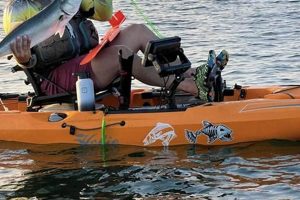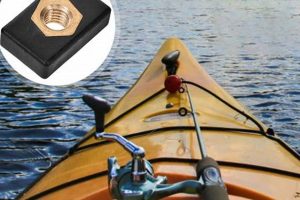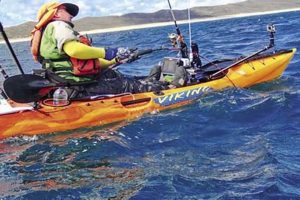Specialized nets designed for use in kayaks assist anglers in securing their catch. These tools are typically crafted from lightweight, corrosion-resistant materials with a teardrop or triangular hoop shape and a handle optimized for maneuverability in a confined cockpit. A rubberized or coated netting minimizes harm to the fish and prevents hooks from becoming entangled.
Securing a hooked fish while maintaining balance and control in a kayak presents unique challenges. These specialized nets offer a crucial advantage, facilitating safe and efficient retrieval of fish. Their compact design and specialized features are crucial for kayak anglers. This equipment protects both the angler and the catch, allowing for quicker releases and minimizing stress on the fish. Historically, kayak anglers may have adapted general-purpose nets, but the development of purpose-built designs has significantly improved the fishing experience from a kayak.
Further exploration will delve into various net features, including handle lengths, hoop sizes, and netting materials. Proper techniques for utilizing these nets from a kayak will also be discussed, along with maintenance and storage recommendations.
Tips for Effective Netting
Proper use of a specialized landing net ensures efficient fish retrieval and promotes conservation. The following tips offer guidance on maximizing the effectiveness of these tools in a kayak fishing environment.
Tip 1: Choose the Right Net: Net size should correspond to the target species. Larger fish require larger hoops, while smaller species benefit from finer mesh netting to prevent escape.
Tip 2: Position the Net Strategically: Submerge the net below the fish before attempting to scoop upwards. This prevents startling the fish and reduces the risk of losing it at the surface.
Tip 3: Secure the Fish Quickly: Once the fish is in the net, lift it clear of the water and securely into the kayak. Minimize handling time to reduce stress on the fish.
Tip 4: Maintain Net Control: A firm grip on the handle is crucial, particularly in challenging conditions. Consider a net with a lanyard for added security.
Tip 5: Proper Storage: Store the net securely when not in use, ensuring it does not interfere with paddling or other fishing activities. Consider a retractable or foldable design for space efficiency.
Tip 6: Regular Maintenance: Rinse the net with fresh water after each use to remove saltwater and debris. This prolongs the lifespan of the net and prevents corrosion.
Tip 7: Consider Net Features: Features such as rubberized netting and non-slip handles enhance performance and minimize harm to the fish.
Following these guidelines ensures efficient fish landing while minimizing stress on both the angler and the catch. Proper net selection and utilization contribute significantly to a successful kayak fishing experience.
The subsequent section will address frequently asked questions regarding these essential tools.
1. Portability
In kayak fishing, where space and weight are at a premium, portability is a paramount concern for all equipment, including landing nets. A cumbersome net hinders maneuverability and efficiency within the confined space of a kayak. Effective net deployment requires ease of access and stowage, underscoring the importance of portability.
- Compact Design:
Landing nets designed for kayak fishing often feature telescoping or foldable handles and collapsible hoops. These designs minimize storage space and allow for quick deployment and efficient stowage when not in use. For example, a telescoping handle can reduce a net’s length by half, facilitating easy storage under a seat or behind a crate.
- Lightweight Construction:
Materials such as aluminum, carbon fiber, or reinforced plastics offer strength and durability while minimizing weight. A lightweight net reduces overall kayak load and fatigue during extended fishing trips. A heavier net can become cumbersome and difficult to manage, especially in challenging conditions. The difference between an aluminum and a heavier steel net can be substantial, influencing angler fatigue.
- Storage Solutions:
Dedicated net holders or attachment points further enhance portability. These accessories keep the net secure and readily accessible while preventing entanglement with other gear. Examples include clips, straps, or magnetic mounts specifically designed for kayak use, allowing for easy access and minimizing interference.
- Balanced Design:
Even a lightweight and compact net can feel cumbersome if poorly balanced. A well-designed net distributes weight evenly, minimizing strain during use and facilitating precise control. This is particularly important when handling larger fish, where an unbalanced net can compromise stability.
These facets of portability contribute significantly to the overall effectiveness of a kayak fishing landing net. A portable net is easily deployed, stored, and managed, enhancing the angler’s efficiency and enjoyment on the water. Choosing a net that balances portability with functionality is crucial for a successful kayak fishing experience.
2. Durability
Landing nets employed in kayak fishing face demanding conditions, including exposure to saltwater, UV radiation, and potential impacts. Durability is therefore paramount, ensuring the net withstands these rigors and maintains functionality over extended use. A durable net represents a worthwhile investment, minimizing replacement costs and ensuring reliability during critical moments.
- Material Selection:
Net construction materials directly influence durability. Marine-grade aluminum, reinforced plastics, and corrosion-resistant coatings are commonly used to combat saltwater corrosion and wear. A net constructed with inferior materials may quickly degrade, necessitating frequent replacement. For instance, a stainless steel hoop offers superior corrosion resistance compared to a standard steel hoop, prolonging lifespan in saltwater environments.
- Netting Strength:
The netting itself must withstand the weight and struggles of landed fish. Durable netting options include knotless, rubberized, or coated meshes. Knotless netting eliminates weak points that can fray or tear, while rubberized coatings enhance resistance to abrasion and punctures from sharp fins or teeth. A weak net may fail when landing a sizable fish, leading to its escape and potential damage to the net.
- Handle Construction:
The handle constitutes a critical component subject to stress during fish landing. Reinforced composite materials or high-grade aluminum provide the necessary strength and rigidity while minimizing weight. Handles constructed from brittle or weak materials may crack or break under pressure. A telescopic handle with robust locking mechanisms maintains rigidity and resists bending or collapsing during use.
- Construction Quality:
Overall construction quality significantly impacts durability. Reinforced joints, tightly woven netting, and quality hardware ensure the net withstands regular use and the occasional mishap. Poorly constructed nets are prone to premature failure, particularly at stress points like net-to-hoop connections or handle joints. Double-stitched seams and reinforced connections enhance the net’s longevity and resistance to wear and tear.
These factors combine to determine a kayak fishing landing net’s overall durability. Investing in a durable net ensures reliable performance, reduces replacement costs, and contributes to a positive fishing experience. While initial cost may be higher, a durable net provides long-term value and dependable functionality in demanding environments.
3. Net Material
Net material significantly influences the effectiveness and longevity of kayak fishing landing nets. The chosen material impacts fish handling, net durability, and overall performance. Careful consideration of material properties is essential for selecting a net appropriate for specific fishing conditions and target species.
- Durability and Abrasion Resistance:
Netting must withstand abrasion from fish scales, teeth, and spines, as well as environmental factors like rocks and submerged debris. Rubberized or coated meshes offer enhanced abrasion resistance compared to traditional nylon or monofilament netting. For example, a rubber-coated net is less likely to tear or fray when landing abrasive species like catfish or toothed fish like pike, ensuring longer net lifespan.
- Fish-Friendliness:
Minimizing harm to the fish is a crucial aspect of responsible angling. Rubberized or silicone-coated netting materials are gentler on fish scales and slime coats compared to traditional netting, reducing the risk of injury and infection. This is particularly important for catch-and-release fishing, where preserving fish health is paramount. A silicone-coated net allows for safer handling of delicate species like trout, promoting their survival after release.
- Hook Tangle Resistance:
Hook entanglement can be a frustrating and time-consuming issue. Knotless netting, especially in finer mesh sizes, minimizes the risk of hooks becoming snagged, facilitating quicker releases and reducing stress on both the fish and the angler. This is beneficial when fishing with treble hooks or in snag-prone environments. A knotless mesh significantly reduces the likelihood of treble hooks becoming embedded, allowing for efficient hook removal and minimizing fish handling time.
- Water Absorption and Drying Time:
Net material impacts water absorption and drying time. Non-absorbent materials like rubber and silicone dry quickly, preventing the growth of mildew and odors and minimizing weight gain during use. This is advantageous in kayak fishing, where storage space is limited and quick drying is essential to prevent gear from becoming damp and heavy. A quickly drying net is also less prone to developing unpleasant odors over time, maintaining a more hygienic fishing environment.
The selection of appropriate net material directly impacts the functionality and longevity of kayak fishing landing nets. Balancing durability, fish-friendliness, and practicality is key to selecting a net that meets specific angler needs and promotes responsible fishing practices. Matching net material properties to target species and fishing environments ensures optimal performance and contributes to a positive fishing experience.
4. Hoop Size
Hoop size is a critical factor influencing the effectiveness of kayak fishing landing nets. Appropriate hoop dimensions directly correlate with successful fish landing and overall angling efficiency. An incorrectly sized hoop can lead to missed landings, increased fish handling time, and potential harm to both the fish and the angler. Selecting the correct hoop size requires careful consideration of target species and kayak dimensions.
Larger hoops offer a wider target area, increasing the likelihood of successful landing, particularly for larger or faster-moving fish. However, larger hoops also increase wind resistance and can be cumbersome to maneuver within the confined space of a kayak cockpit. Conversely, smaller hoops offer greater maneuverability and control but may prove inadequate for landing larger fish, increasing the chance of escape or prolonged struggles. For example, landing a large salmon in a small trout net is significantly more challenging and risks damaging both the net and the fish. Conversely, using an oversized net for panfish can be awkward and inefficient. The balance between hoop size and maneuverability is crucial for efficient net deployment and retrieval.
Practical considerations extend beyond simply matching hoop size to target fish size. Kayak dimensions and fishing style also influence appropriate hoop selection. A larger kayak with ample cockpit space may accommodate a larger hoop, while a smaller kayak requires a more compact net for efficient handling. Similarly, anglers fishing in open water may prefer a larger hoop for increased landing success, while those fishing in tight quarters or heavily vegetated areas benefit from a smaller, more maneuverable hoop. Understanding the interplay of these factors allows anglers to select a hoop size optimized for their specific needs, maximizing landing efficiency and minimizing potential difficulties.
5. Handle Length
Handle length is a critical factor influencing the practicality and effectiveness of kayak fishing landing nets. Appropriate handle length facilitates efficient fish retrieval while maintaining balance and control within the confined space of a kayak. An excessively long handle can be cumbersome and difficult to manage, potentially interfering with paddling and other onboard activities. Conversely, a handle that is too short limits reach, increasing the difficulty of landing fish, especially in deeper water or when dealing with longer fish. The optimal handle length balances reach and maneuverability, allowing for efficient net deployment and retrieval without compromising stability.
Consider the scenario of landing a larger fish alongside a kayak. A longer handle provides the necessary reach to securely net the fish without requiring excessive leaning or maneuvering. This minimizes the risk of capsizing and facilitates controlled fish handling. Conversely, a shorter handle necessitates awkward positioning and increases the chance of losing the fish or even tipping the kayak. In situations involving swift currents or challenging water conditions, a longer handle allows the angler to maintain a safe distance while still effectively netting the fish. However, within confined spaces such as mangrove tunnels or densely vegetated areas, a shorter handle offers greater maneuverability and reduces the risk of entanglement. Therefore, the ideal handle length depends on the specific fishing environment and target species.
Selecting the appropriate handle length requires careful consideration of kayak dimensions, fishing style, and target species. Anglers fishing from larger kayaks with ample cockpit space may benefit from a longer handle for increased reach. Those fishing in smaller kayaks or tight quarters may prefer a shorter, more maneuverable handle. The trade-off between reach and maneuverability is crucial for efficient net deployment and retrieval. Understanding this balance empowers anglers to choose a landing net handle length optimized for their specific needs and fishing environment, maximizing efficiency and ensuring a safe and productive fishing experience.
6. Ease of Use
In the specialized context of kayak fishing, ease of use is a critical factor influencing landing net effectiveness. Efficient deployment, secure fish retrieval, and effortless stowage are essential for a seamless and productive fishing experience. A cumbersome or difficult-to-manage net can disrupt the angling process, leading to missed opportunities and frustration. The following facets highlight key elements contributing to ease of use in kayak fishing landing nets.
- Deployment and Retrieval:
Rapid deployment and smooth retrieval are paramount for maximizing fishing time and minimizing disruption. Features like telescoping handles with secure locking mechanisms and quick-release attachments facilitate efficient one-handed operation. A net that requires complex setup or struggles to retract smoothly hinders the angler’s ability to react quickly to landing opportunities. For example, a tangled or jammed telescoping handle can lead to missed catches and frustration.
- Secure Grip and Control:
Maintaining a secure grip on the net handle, even with wet hands or in challenging conditions, is crucial for controlled fish landing. Ergonomic handle designs with non-slip grips enhance comfort and control, minimizing the risk of dropping the net or losing a fish. A poorly designed handle can compromise grip, potentially leading to lost fish and even jeopardizing angler safety.
- Stowage and Accessibility:
Secure and readily accessible net stowage is essential for maintaining a clutter-free kayak cockpit and ensuring the net is readily available when needed. Dedicated net holders, clips, or magnetic mounts keep the net secure and within easy reach, minimizing interference with paddling and other fishing activities. A net that lacks secure stowage can become entangled with other gear or create an obstruction in the limited space of a kayak.
- Lightweight Design:
A lightweight net reduces fatigue during extended fishing trips and facilitates effortless handling. Materials such as aluminum or carbon fiber offer strength and durability without adding excessive weight. A heavy or cumbersome net can tire the angler and hinder maneuverability, particularly when landing larger fish or in challenging conditions.
These facets of ease of use significantly influence the overall effectiveness and enjoyment of kayak fishing. A well-designed net simplifies the landing process, allowing anglers to focus on the fishing experience rather than struggling with their equipment. Prioritizing ease of use ensures efficient fish retrieval, minimizes disruptions, and contributes to a more productive and enjoyable time on the water. The careful selection of a user-friendly net enhances angling success and promotes a positive overall experience.
7. Corrosion Resistance
Corrosion resistance is paramount for kayak fishing landing nets due to the constant exposure to saltwater, spray, and humid environments. A net lacking adequate corrosion resistance will degrade rapidly, compromising functionality and necessitating frequent replacement. This discussion explores the critical facets of corrosion resistance in landing nets, highlighting its impact on material selection, construction, maintenance, and overall longevity.
- Material Selection:
Net construction materials significantly influence corrosion resistance. Aluminum alloys, particularly marine-grade variants, offer inherent corrosion resistance due to the formation of a protective oxide layer. Similarly, stainless steel, known for its high chromium content, exhibits excellent resistance to rust and corrosion in saltwater environments. Conversely, less corrosion-resistant materials like standard steel quickly succumb to rust, compromising structural integrity and shortening lifespan. Choosing appropriate materials is fundamental to ensuring long-term net durability.
- Coatings and Finishes:
Protective coatings and finishes further enhance corrosion resistance. Powder coating, anodizing (for aluminum), and specialized marine paints create a barrier against saltwater and environmental elements, delaying the onset of corrosion. These coatings not only protect the underlying metal but also enhance aesthetics and facilitate cleaning. Regular inspection and maintenance of these coatings are essential to maintaining their protective properties.
- Hardware and Fasteners:
Small components like rivets, screws, and other fasteners are also susceptible to corrosion. Using stainless steel or corrosion-resistant alloys for these components is crucial to preventing failure and maintaining structural integrity. A single corroded fastener can compromise the entire net, highlighting the importance of considering even seemingly minor components.
- Maintenance Practices:
Even with corrosion-resistant materials and coatings, proper maintenance is crucial for prolonging net lifespan. Rinsing the net with fresh water after each use removes salt deposits and minimizes corrosive action. Regular inspection for signs of corrosion, such as pitting or discoloration, allows for timely intervention and prevents further damage. Proper storage in a dry, ventilated area further minimizes the risk of corrosion.
Corrosion resistance directly impacts the longevity, functionality, and overall value of kayak fishing landing nets. Selecting nets constructed from corrosion-resistant materials, incorporating protective coatings, and adhering to proper maintenance practices ensures optimal performance and extends the lifespan of this essential piece of kayak fishing equipment. Investing in a corrosion-resistant net minimizes replacement costs and ensures reliable performance in demanding saltwater environments.
Frequently Asked Questions
Addressing common inquiries regarding specialized landing nets for kayak fishing provides clarity and facilitates informed purchasing decisions. The following questions and answers offer practical insights into key considerations for selecting and utilizing these essential tools.
Question 1: What net material is best suited for saltwater kayak fishing?
Rubberized or silicone-coated netting offers superior corrosion resistance and minimizes harm to fish. These materials also resist hook entanglement and dry quickly, essential features in saltwater environments.
Question 2: How does hoop size affect landing success in a kayak?
Larger hoops provide a greater target area but can be cumbersome in a kayak. Smaller hoops offer better maneuverability but may be inadequate for larger fish. Hoop size should be selected based on target species and kayak dimensions.
Question 3: What is the ideal handle length for a kayak fishing landing net?
Optimal handle length balances reach and maneuverability. Longer handles provide extended reach but can be awkward in tight spaces. Shorter handles offer better control but may limit reach. Consider kayak dimensions and fishing environment when selecting handle length.
Question 4: How can hook entanglement be minimized when using a landing net?
Knotless netting, especially in finer mesh sizes, significantly reduces hook tangling. Rubberized coatings also help prevent hooks from becoming embedded in the net material.
Question 5: What maintenance is required for a kayak fishing landing net?
Rinsing the net with fresh water after each use removes salt and debris, prolonging its lifespan. Regular inspection for signs of wear or corrosion and proper storage in a dry, ventilated area are also essential.
Question 6: Are foldable or telescoping landing nets beneficial for kayak fishing?
Foldable or telescoping nets offer significant advantages in kayak fishing due to their compact storage size. These designs maximize space efficiency and allow for easy deployment and stowage.
Careful consideration of these frequently asked questions empowers anglers to make informed decisions regarding landing net selection and utilization, enhancing fishing success and enjoyment on the water.
The next section will provide a concluding overview of key takeaways and recommendations for selecting the ideal kayak fishing landing net.
Kayak Fishing Landing Nets
Effective kayak fishing necessitates specialized equipment, and landing nets are no exception. Careful consideration of material, hoop size, handle length, ease of use, and corrosion resistance ensures optimal performance and longevity. Prioritizing these factors equips anglers with reliable tools for secure and efficient fish retrieval, contributing significantly to a successful kayak fishing experience. The proper selection and utilization of specialized landing nets directly impacts both angling efficiency and fish conservation efforts.
Investing in a high-quality, purpose-designed landing net tailored to specific kayak fishing needs represents a commitment to both successful angling and responsible fish handling. This specialized equipment empowers anglers to effectively navigate the unique challenges of kayak fishing, ensuring a positive and productive experience on the water. Successful kayak angling requires a holistic approach, where equipment selection plays a crucial role.






